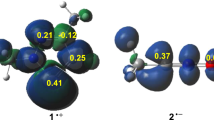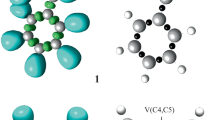Abstract
[3 + 2] cycloaddition (32CA) reaction of C,N-diaryl nitrone with benzylidene acetone has been studied to analyse the mechanism, selectivity and polar character of this nitrone-enone cycloaddition. Topological analysis of the electron localization function (ELF) shows the absence of pseudoradical and carbenoid centre in the nitrone, which allows its classification as a zwitter-ionic (zw) type three atom component (TAC) and hence participation in zw- type cycloadditions is associated with high activation energy barriers. This 32CA reaction follows a one-step mechanism with asynchronous TSs. Endo/meta product is obtained as the major cycloadduct experimentally, which can be rationalized from its calculated lowest activation energy among the four possible reaction pathways. Global electron density transfer (GEDT) at the TSs predict the non-polar character of this 32CA reaction. Topological analysis of the ELF and QTAIM parameters was performed at the TSs. Finally, non-covalent interaction (NCI) gradient isosurfaces are computed to obtain a visualization of non-covalent interactions at the interatomic bonding regions.
Graphic Abstract
The experimental and theoretical aspects of [3+2] cycloaddition reactions of C,N-diaryl nitrone with benzylidene acetone is described. The reaction is meta/endo selective and follows one step mechanism with non-covalent interactions. The C-C and C-O bonds are generated through coupling of pseudoradical centers.










Similar content being viewed by others
References
Grigor’ev I A 2007 In Nitrile Oxides, Nitrones, and Nitronates in Organic Synthesis H Feuer (Ed.) (Wiley: Hoboken, New Jersey) p. 129
Jones R C F and Martin J N 2002 In Synthetic Application of 1,3-Dipolar Cycloaddition Chemistry Toward Heterocycles and Natural Products A Padwa and W H Pearson (Eds.) (Wiley: New York) p.1
Chiacchio M A, Giofrè S V, Romeo R, Romeo G and Chiacchio U 2016 Isoxazolidines as Biologically Active Compounds Curr. Org. Syn. 13 726
Romeo G, Chiacchio U, Corsaro A and Merino P 2010 Chemical Synthesis of Heterocyclic-Sugar Nucleoside Analogues Chem. Rev. 110 3337
Gothelf K V and Jørgensen K A 1998 Asymmetric 1,3-Dipolar Cycloaddition Reactions Chem. Rev. 98 863
Zhang Q Y Z, Jia Z, Yang C, Zhang L and Luo S 2019 Asymmetric 1,3-Dipolar Cycloaddition Reactions of Enones by Primary Amine Catalysis Asian J. Org. Chem. 8 1049
Fukui K, Yonezawa T and Shingu H 1952 A Molecular Orbital Theory of Reactivity in Aromatic Hydrocarbons J. Chem. Phys. 20 722
Domingo L R 2016 Molecular Electron Density Theory: A Modern View of Reactivity in Organic Chemistry Molecules 21 1319
Gutiérrez M R and Domingo L R 2019 Unravelling the Mysteries of the [3 + 2] Cycloaddition Reactions Eur. Jour. Org. Chem. 267
Domingo L R, Gutiérrez M R- and Pérez P 2017 How does the global electron density transfer diminish activation energies in polar cycloaddition reactions? A Molecular Electron Density Theory study Tetrahedron 73 1718
Domingo L R 2014 A new C–C bond formation model based on the quantum chemical topology of electron density RSC Adv. 4 32415
Domingo L R, Gutiérrez M R- and Pérez P 2018 A Molecular Electron Density Theory Study of the Reactivity and Selectivities in [3 + 2] Cycloaddition Reactions of C,N-Dialkyl Nitrones with Ethylene Derivatives J. Org. Chem. 83 2182
Becke A D and Edgecombe K E 1990 A simple measure of electron localization in atomic and molecular systems J. Chem. Phys. 92 5397
Silvi B and Savin A 1994 Classification of chemical bonds based on topological analysis of electron localization functions Nature 371 683
Domingo L R, Gutiérrez M R and Pérez P 2016 Applications of the Conceptual Density Functional Theory Indices to Organic Chemistry Reactivity Molecules 21 748
Bader R F W 1990 Atoms in Molecules: A Quantum Theory (Oxford: Clarendon Press)
Kumar P S V, Raghavendra V and Subramanian V 2016 Bader’s Theory of Atoms in Molecules (AIM) and its Applications to Chemical Bonding J. Chem. Sci. 128 1527
Bader R F W and Essén H 1984 The characterization of atomic interactions J. Chem. Phys. 80 1943
García J C-, Johnson E R, Keinan S, Chaudret R, Piquemal J -P, Beratan D N and Yang W 2011 NCIPLOT: A Program for Plotting Noncovalent Interaction Regions J. Chem. Theory Comput. 73 625
Becke A D 1988 Density-functional exchange-energy approximation with correct asymptotic behavior Phys. Rev. A 38 3098
Lee C, Yang W and Parr R G 1988 Development of the Colle-Salvetti correlation-energy formula into a functional of the electron density Phys. Rev. B 37 785
Domingo L R, Aurell M J and Pérez P 2015 A mechanistic study of the participation of azomethine ylides and carbonyl ylides in [3 + 2] cycloaddition reactions Tetrahedron 71 1050
Jasiński R 2015 In the searching for zwitter ionic intermediates on reaction paths of [3 + 2] cycloaddition reactions between 2,2,4,4-tetramethyl-3-thiocyclobutanone S-methylide and polymerizable olefins RSC Adv. 5 101045
Kącka- Zych A, Domingo L R, Gutiérrez M R and Jasiński R 2017 Understanding the mechanism of the decomposition reaction of nitroethyl benzoate through the Molecular Electron Density Theory Theor. Chem. Acc. 136 129
González C and Schlegel H B 1990 Reaction path following in mass-weighted internal coordinates J. Phys. Chem. 94 5523
González C and Schlegel H B 1991 Improved algorithms for reaction path following: Higher-order implicit algorithms J. Chem. Phys. 95 5853
Tomasi J and Persico M 1994 Molecular Interactions in Solution: An Overview of Methods Based on Continuous Distributions of the Solvent Chem. Rev. 94 2027
Simkin B I A and Sheikhet I I 1995 Quantum chemical and statistical theory of solutions—Computational approach (London, UK: Ellis Horwood)
Cossi M, Barone V, Cammi R and Tomasi J 1996 Ab initio study of solvated molecules: a new implementation of the polarizable continuum model Chem. Phys. Lett. 255 327
Barone V, Cossi M and Tomasi J 1998 Geometry optimization of molecular structures in solution by the polarizable continuum model J. Comput. Chem. 19 404
Reed A E, Weinstock R B and Weinhold F 1985 Natural Population Analysis J. Chem. Phys. 83 735
Reed A E, Curtiss L A and Weinhold F 1988 Intermolecular interactions from a natural bond orbital, donor-acceptor viewpoint Chem. Rev. 88 899
Geerlings P, De Proft F and Langenaeker W 2003 Conceptual Density Functional Theory Chem. Rev. 103 1793
Domingo L R, Aurell M J, Perez P and Contreras R 2002 Quantitative Characterization of the Global Electrophilicity Power of Common Diene/Dienophile Pairs in Diels-Alder Reactions Tetrahedron 58 4417
Gaussian 03, Revision D.01, Frisch M J, Trucks G W, Schlegel H B, Scuseria G E, Robb M A, Cheeseman J R, Montgomery Jr JA, Vreven T, Kudin K N, Burant J C, Millam J M, Iyengar S S, Tomasi J, Barone V, Mennucci B, Cossi M, Scalmani G, Rega N, Petersson GA, Nakatsuji H, Hada M, Ehara M, Toyota K, Fukuda R, Hasegawa J, Ishida M, Nakajima T, Honda Y, Kitao O, Nakai H, Klene M, Li X, Knox J E, Hratchian H P, Cross J B, Bakken V, Adamo C, Jaramillo J, Gomperts R, Stratmann R E, Yazyev O, Austin A J, Cammi R, Pomelli C, Ochterski J W, Ayala P Y, Morokuma K, Voth G A, Salvador P, Dannenberg J J, Zakrzewski V G, Dapprich S, Daniels A D, Strain M C, Farkas O, Malick D K, Rabuck A D, Raghavachari K, Foresman J B, Ortiz J V, Cui Q, Baboul A G, Clifford S, Cioslowski J, Stefanov B B, Liu G, Liashenko A, Piskorz P, Komaromi I, Martin R L, Fox D J, Keith T, Al-Laham M A, Peng C Y, Nanayakkara A, Challacombe M, Gill P M W, Johnson B, Chen W, Wong M W, Gonzalez C and Pople J A, Gaussian, Inc, Wallingford CT, 2004
Lu T and Chen F 2012 Multiwfn: A multifunctional wavefunction analyzer J. Comp. Chem. 33 580
Humphrey W, Dalke A and Schulten K 1996 VMD: visual molecular dynamics J. Mol. Graphics. 14.1 33
Pettersen E F, Goddard T D, Huang C C, Couch G S, Greenblatt D M, Meng E C and Ferrin T E 2004 UCSF Chimera–a visualization system for exploratory research and analysis J. Comput. Chem. 25 1605
Drake N L and Allen P Jr. 1923 Benzalacetone Org. Synth. 3 17
Acharjee N, Banerji A and Prangé T 2010 DFT study of 1,3-dipolar cycloadditions of C,N-disubstituted aldonitrones to chalcones evidenced by NMR and X-ray analysis Monatsh. Chem. 141 1213
Banerji A, Maiti K K, Haldar S, Mukhopadhyay C, Banerji J, Prange´ T and Neuman A 2000 1,3-Dipolar Cycloadditions VI [1].Structure and Conformation of Cycloadducts from Reactions of C-Aryl-N-phenyl nitrones with Substituted Cinnamic Acid Amides Monatsh. Chem. 131 901
Yang W and Mortier W J 1986 The use of global and local molecular parameters for the analysis of the gas-phase basicity of amines J. Am. Chem. Soc. 108 5708
Domingo L R, Pérez P and Sáez J A 2013 Understanding the local reactivity in polar organic reactions through electrophilic and nucleophilic Parr functions RSC Adv. 3 1486
Domingo L R and Acharjee N 2018 [3 + 2] Cycloaddition Reaction of C-Phenyl-N-methyl Nitrone to Acyclic-Olefin-Bearing Electron-Donating Substituent: A Molecular Electron Density Theory Study Chem. Select 3 8373
Acharjee N and Banerji A 2011 DFT interpretation of 1,3-dipolar cycloaddition reaction of C,N-diphenyl nitrone to methyl crotonate in terms of reactivity indices, interaction energy and activation parameters Comput. Theo. Chem. 967 50
Jasiński R, Wąsik K, Mikulskaa M and Barański A 2009 A DFT study on the (2 + 3) cycloaddition reactions of 2-nitropropene-1 with Z-C, N-diarylnitrones J. Phys. Org. Chem. 22 717
Acknowledgements
One of the authors N. Acharjee, is thankful to Professor Manas Banerjee (Retired), University of Burdwan, West Bengal, India for kind cooperation and University of Calcutta for experimental facilities.
Author information
Authors and Affiliations
Corresponding author
Electronic supplementary material
Below is the link to the electronic supplementary material.
Rights and permissions
About this article
Cite this article
ACHARJEE, N., BANERJI, A. A molecular electron density theory study to understand the interplay of theory and experiment in nitrone-enone cycloaddition. J Chem Sci 132, 65 (2020). https://doi.org/10.1007/s12039-020-01766-5
Received:
Revised:
Accepted:
Published:
DOI: https://doi.org/10.1007/s12039-020-01766-5




